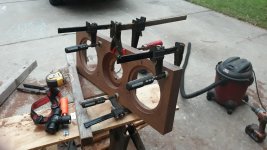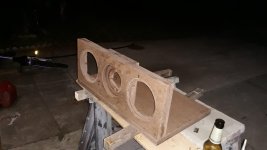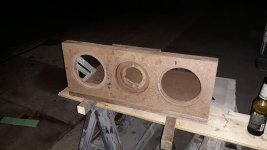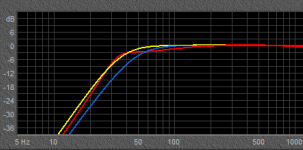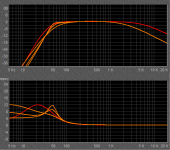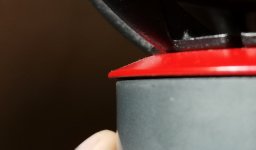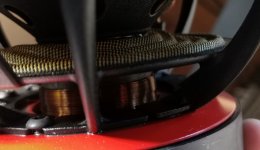Ok Joe perfect. I used a port length calculator...
I used a port calculator to come up with the tuning frequency for the Elsinores and it was out by quite a bit. The port length that worked did not have to be as long as the calculator predicted. The added fill results in the port 'seeing' a much larger volume than a normally lined box.
So my question is does that matter all that much? (Just say no!!!)
I will say no! because that is what you want me to say. 😀
But it is mainly the mass of that MDF block we want, behind the tweeter, so if you got that, then it will be fine.
Joe, while we're on the topic of ports and since I need to change mine, what are your thoughts on the Precision Ports? When I remove mine, I likely won't be able to get a perfectly round hole so will need something that screws in.
4" Precision Ports
They have a port length calculator specific to their product, but I'm concerned with what volume to use since you mention in the prior post that the added fill results in a larger implicit volume.
Alternatively, I could perhaps make something like what Scott used work if I'm really careful. 2pcs Subwoofer Port Tube Bass Vent For 12"/15"/18" Speaker DIY Repair 110x200mm | eBay
Thanks 🙂
4" Precision Ports
They have a port length calculator specific to their product, but I'm concerned with what volume to use since you mention in the prior post that the added fill results in a larger implicit volume.
Alternatively, I could perhaps make something like what Scott used work if I'm really careful. 2pcs Subwoofer Port Tube Bass Vent For 12"/15"/18" Speaker DIY Repair 110x200mm | eBay
Thanks 🙂
The precision Port is a good product. You could try the assembly in the elsinor taping the pieces together until you get the results that match what you need. Do you have a way to test the tuning frequency?
That's a good point. I read a post of someone who tested the tuning frequency very early in this thread, but couldn't find it again. Maybe further research will reveal other tests. Thanks.
You might be able to do it with a impedance sweep. The one thing to consider on a precision part is that they talk about the flared end creating a boost. Also a larger diameter port will take up more space in the cabinet
A shy question. Will Purifi speakers require smaller boxes than SB Acoustics? The electrical-mechanical parameters are so different.
Vas 22L vs 39L
Meanwhile... Black Friday Deal
Order the PURIFI PTT6.5W08-NFA-01 woofer - SoundImports
Vas 22L vs 39L
Meanwhile... Black Friday Deal
Order the PURIFI PTT6.5W08-NFA-01 woofer - SoundImports
Joe, while we're on the topic of ports and since I need to change mine, what are your thoughts on the Precision Ports?
There are many different plastic ports out there and it would be difficult to give anything other than general advice.
Diameter: The larger the diameter the lower the peak velocity and that is good. It reduces the chance of the port making unnecessary noises. But it also means that the port needs to be longer.
Length: We obviously cannot make the length to long because the box dimensions prohibit it. But we also want the port the be able to 'breathe' inside the box. We don't want the air to have obstructions to good air-flow inside the box to port.
Flare: This can reduce noise and turbulence and is not a bad thing. But now we are adding length and that could lead to trouble inside the box as the length may become too long. If the length required is 100mm and there is a flare, then if the flare is 20mm, then the port needs to be 120mm long. Maybe a good compromise is the flare should be at the entrance from outside the box and no flare inside. Like this, but of course it could be all black ABS and not necessarily two-piece:

Tuning frequency: This is what you don't want to change. You will need to do a low-frequency impedance measurement and see where the bottom of the saddle is - I would like that to be around 33-34 Hertz. But the LCR with 18mH choke should not be connected when testing.
Hope that helps.
The precision... You could try the assembly in the elsinor taping the pieces together until you get the results that match what you need. Do you have a way to test the tuning frequency?
Good advice, it's about the tuning frequency.
You might be able to do it with a impedance sweep. The one thing to consider on a precision part is that they talk about the flared end creating a boost. Also a larger diameter port will take up more space in the cabinet
Correct. I do think the 3dB claim is a bit optimistic IMO. It is more about reducing noise because the air flows more smoothly.
A shy question. Will Purifi speakers require smaller boxes than SB Acoustics?
Not necessarily. This is where I need to have the driver before me and compare the T-S Parameters and compare to my known drivers here. Note that the comparison can only be done on the same setup so that they can be compared and then the difference numbers can be crunched. It isn't just the difference in VAS that is important - and that low VAS may not show up with my setup as that low. But what is certain, to make the new drivers work in our box, it looks like a higher tuning frequency is required. I tune it to give the closest thing to what looks like a Bessel fall-off in frequency.
There is also another thing, the Elsinore box working as a reflex is much more resistive than normal vented boxes. One of the two major reasons I knew I could not use the first "X" drivers Purifi brought out was the very low Q they had and the "W" does not. Also that the new "W" drivers now match the sensitivity of the drivers we have used so far.
But this comes down to finding the best tuning for the box we have got. The port will definitely need to be a bit shorter, we shall see by how much.
Last edited:
Yellow should be approximately what the Elsinore/SB is now. Blue suggests an optimum regular damped vented box for the Purify at just under half the box volume. Red suggests what you might see with the Purify in a regular larger box.A shy question. Will Purifi speakers require smaller boxes than SB Acoustics? The electrical-mechanical parameters are so different.
Vas 22L vs 39L
Attachments
There is also another thing, the Elsinore box working as a reflex is much more resistive than normal vented boxes. One of the two major reasons I knew I could not use the first "X" drivers Purifi brought out was the very low Q they had and the "W" does not. Also that the new "W" drivers now match the sensitivity of the drivers we have used so far.
But this comes down to finding the best tuning for the box we have got. The port will definitely need to be a bit shorter, we shall see by how much.
Yellow should be approximately what the Elsinore/SB is now. Blue suggests an optimum regular damped vented box for the Purify at just under half the box volume. Red suggests what you might see with the Purify in a regular larger box.
So some correction may be necessary. Even for ready-made boxes, it is easier to reduce the capacity than to enlarge.
Thanks for the clarification. I will not be making new boxes until spring, so I am waiting for the riddle to be solved in a practical way.
Last edited:
Hi Allen
I have done similar in WinISD to get an idea. But I can tell you that the SB driver is closer to 39Hz with 6V input (near max what ClioFW-01 outputs).

What is interesting is that I have a classic Vifa P17WJ-00-08 driver. This is one of the original and not the newer Scan-Speak reissue, which I trust would be good too. My version on the ClioFW-01 tests was a lot closer to the published specs than the SB17MFC35-08 does, so go figure this out.
If you look at the specs of the "X" version and compare it with the version "W" we are using, I am guessing that the main reason is the lower mass is the coil mass is lower and the same cone and suspension used. "X" mass is 24.4g and "W" mass is 19.4g - that is quite a big difference. I am sure the cone, suspension and surround are the same. This would explain the higher Fs. This makes we wonder if I am going to measure a higher VAS than 22L in my setup.
Allen, may I point what I said at the very beginning in Post #4271:
I wonder had a driver and a box where everything pointed to 55Hz as the right tuning. It was a 5.25" SB driver and the box was already made and had the right tuning with the port fitted at the back of the box. It was lined with felt. But I applied around 60-70% of fill and the box tuning dropped to 45 Hertz. It did not behave as predicted, which meant that it should have sounded over-damped. It did not, in fact, I played it for a number of people who just couldn't believe what they sounded like. I put it next to a much bigger speakers and forgot which was hooked up and had a few in the room. Even I was misled as were the others in the room. And it could handle heaps of volume too.
All I am saying Allen, is that the box will work. But will I be happy to see a VAS higher than 22L? It would make me a bit more comfortable, but I can still see that it will work, but the port tuning will change for sure.
Hope you are satisfied with the above explanation.
Cheers, Joe
I have done similar in WinISD to get an idea. But I can tell you that the SB driver is closer to 39Hz with 6V input (near max what ClioFW-01 outputs).
What is interesting is that I have a classic Vifa P17WJ-00-08 driver. This is one of the original and not the newer Scan-Speak reissue, which I trust would be good too. My version on the ClioFW-01 tests was a lot closer to the published specs than the SB17MFC35-08 does, so go figure this out.
If you look at the specs of the "X" version and compare it with the version "W" we are using, I am guessing that the main reason is the lower mass is the coil mass is lower and the same cone and suspension used. "X" mass is 24.4g and "W" mass is 19.4g - that is quite a big difference. I am sure the cone, suspension and surround are the same. This would explain the higher Fs. This makes we wonder if I am going to measure a higher VAS than 22L in my setup.
Allen, may I point what I said at the very beginning in Post #4271:
The box will be identical, but the holes and rebating of the driver will be different. The tuning using the port may also need to be tweaked, the port may need to be a bit shorter, perhaps 60mm. It may fall ever so short of bass extension compared to SB17MFC, but that may not even be noticeable.
I wonder had a driver and a box where everything pointed to 55Hz as the right tuning. It was a 5.25" SB driver and the box was already made and had the right tuning with the port fitted at the back of the box. It was lined with felt. But I applied around 60-70% of fill and the box tuning dropped to 45 Hertz. It did not behave as predicted, which meant that it should have sounded over-damped. It did not, in fact, I played it for a number of people who just couldn't believe what they sounded like. I put it next to a much bigger speakers and forgot which was hooked up and had a few in the room. Even I was misled as were the others in the room. And it could handle heaps of volume too.
All I am saying Allen, is that the box will work. But will I be happy to see a VAS higher than 22L? It would make me a bit more comfortable, but I can still see that it will work, but the port tuning will change for sure.
Hope you are satisfied with the above explanation.
Cheers, Joe
Last edited:
If you believe I could make that determination after 5 minutes on a simulator, then you give me far too much credit 🙂
It is clear you will explore damping, and then some of the many other options.
Others might be interested to know that group delay can be used in this process. This shows how fast the response turns. It is related to phase. For example...
The orange responses with different degrees of damping. Less damping can show a greater bass response, it comes with a quicker downturn, and this is shown as a group delay peak indicating the higher rate of phase change.
It is clear you will explore damping, and then some of the many other options.
Others might be interested to know that group delay can be used in this process. This shows how fast the response turns. It is related to phase. For example...
The orange responses with different degrees of damping. Less damping can show a greater bass response, it comes with a quicker downturn, and this is shown as a group delay peak indicating the higher rate of phase change.
Attachments
Allen, I am not exactly sure what you are fishing about for. But I do keep an eye on GD via SoundEasy (software from Bodzio in Melbourne and chances are you know it) and I generally know what to look for. Being a textbook jockey does not interest me, the real world does. But if I have you right, the gradual Bessel-like fall-off is what we want to see. This what you were getting at? It is also the way you get a flatter and even response in the room.
Purifi has told me that the first batch of eight will be sent to me first. I will run in one of the drivers using a gadget I have here, I will measure the T-S Params as it runs in and see where it all stabilises. Then I will check it against the SB17MFC35-08 driver as well as the Vifa P17WJ-08 driver - at this point, it will be the difference in measurements that will tell me what I am likely to get even before mounting the drivers in the box. All three drivers are likely to have Fs in the 37-40 Hertz range.
Purifi has told me that the first batch of eight will be sent to me first. I will run in one of the drivers using a gadget I have here, I will measure the T-S Params as it runs in and see where it all stabilises. Then I will check it against the SB17MFC35-08 driver as well as the Vifa P17WJ-08 driver - at this point, it will be the difference in measurements that will tell me what I am likely to get even before mounting the drivers in the box. All three drivers are likely to have Fs in the 37-40 Hertz range.
Last edited:
Warning.
Yesterday I reached for one of the Purifi speakers to demonstrate to someone. The diaphragm stood as still as stone. The entire magnetic system was strongly shifted in relation to the speaker basket.
A very great force must have acted. Coil blocked very hard. Suspension deformed.
The rest of the speakers are fine. Interestingly, there are no strong distortions in the cardboard covers of the box. The package itself, in which they arrived, showed no signs of damage.
Get a good look at your speakers upon receipt from the supplier. There can be unpleasant surprises.
The red perimeter of the basket must be centric to the magnet.
Yesterday I reached for one of the Purifi speakers to demonstrate to someone. The diaphragm stood as still as stone. The entire magnetic system was strongly shifted in relation to the speaker basket.
A very great force must have acted. Coil blocked very hard. Suspension deformed.
The rest of the speakers are fine. Interestingly, there are no strong distortions in the cardboard covers of the box. The package itself, in which they arrived, showed no signs of damage.
Get a good look at your speakers upon receipt from the supplier. There can be unpleasant surprises.
The red perimeter of the basket must be centric to the magnet.
Attachments
JarBar - You sure seeing as thanksgiving is now big in your neck of the woods you didn't use the Purifi driver to slam Tequila 😀 in (joking)? This **** happens freighting to Australia - damage is off the charts! Anyway if not freight damage then quality control ? Slave labour ?
Be interesting to see their explanation.
Be interesting to see their explanation.
Warning.
And you picked those up in person correct? So not shipping damage but quality control or ?
- Home
- Loudspeakers
- Multi-Way
- The "Elsinore Project" Thread
